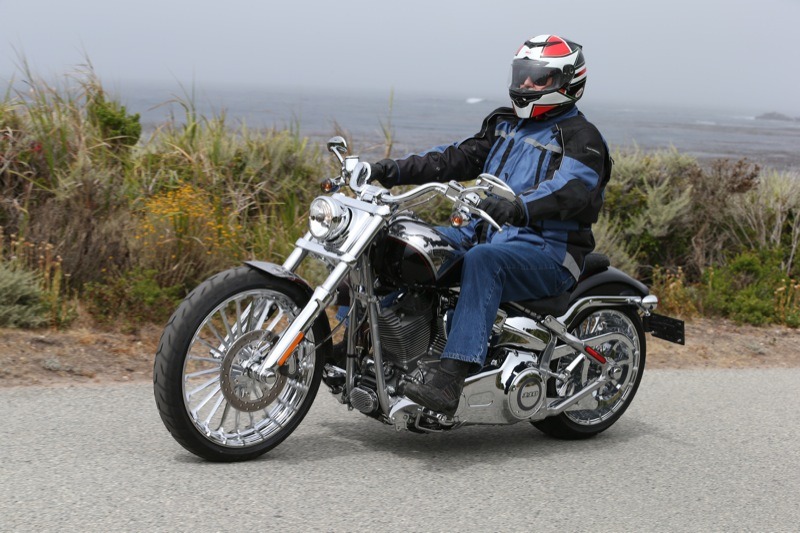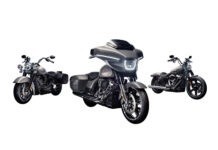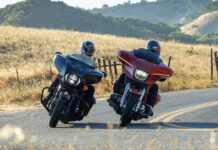CARMEL, CALIF., July 10-11 — You’ve got to hand it to Milwaukee’s marketing mavens: They do know how to move bikes. Back in 1999 when the company started the Custom Vehicle Operation there were many, especially in the press, who wondered out loud if this were truly a wise idea, to make already expensive motorcycles even more expensive. It turns out that it was, and continues to be, which is why marketing types tend to live in large houses with swimming pools, and journalists feel fortunate if their homes don’t get repossessed.
Not only did the CVO survive and thrive, it created a cult of its own within the larger H-D ridership—riders who insist on the finest and most exclusive specimens Milwaukee produces and cost be damned. Purchasing one of these machines brings admission to a very elite club, and that membership does not come cheap.

The least expensive of the 2013 CVO offerings is the new Softail Breakout for a mere $26,400. From there the pricing steps up all the way up to the 110th Anniversary Edition of the Electra Glide Ultra Classic, going for a cool $38,599, including a $1,000 upcharge for the Anniversary treatment—$43,000 out-the-door in California after setup, taxes and the rest are added in. Between those extremes are the other two offerings in the 2013 collection, the new CVO Road King and the returning CVO Road Glide Custom, priced at $29,999 and $32,999 respectively with, again, a $1,000 uptick for the Anniversary versions.
Speaking of money, Harley does know painfully well that we are slowly coming out of a major recession, and sales are certainly not what they were seven or eight years ago. The company is also aware that 85 percent of working Americans are employed, and the economy is getting better. And that there are a lot of motorcycle folk who may not count 40 large as small change, but, heck, that’s the price of a respectable car. Take your choice. Add to that the fact that Harley has been expanding in markets like India and China, which also have very wealthy elites, and all those CVOs will get sold. As some pundit put it succinctly, to be successful you just have to build one less than what the market will bear… which is why CVO production is definitely limited.
For 2013 Harley has customized four bikes, an Ultra Classic Electra Glide, a Road Glide Custom, a Road King, and a Softail model they’ve dubbed the Breakout, all with the Twin Cam 110 c.i. engines. With three of these—exempting the Softail—also having 110th Anniversary versions, celebrating the impressive fact that Harley has been producing motorcycles for a very long time. Harley sent press launch invites (summonses?) to a dozen magazines, and not surprisingly a dozen editors showed up. We’re savvy enough to know that if a company is going to promote an expensive bike, it is not going to house us in a Motel 6, two to a room. The venue alone should be worth the trip, and here it was the Carmel Valley Ranch, a few miles east of Carmel, California. Very nice, with a golf course and spa, the room rates start at $500. We would be well housed, well fed, and well libated—after the riding day was over.

First morning we were treated to an extensive buffet breakfast, with health-conscious people opting for fruit and granola, others piling on the sausages, rashers of bacon, cheese-covered scrambled eggs and loads of caffeine. Breakfast was followed by the official intro, with members of the CVO staff extolling the virtues of each machine. As the old saying goes, given the chance these guys could sell refrigerators to Eskimos. General info told us that all 2013 CVO models are equipped with anti-lock braking systems, electronic cruise control and the Smart Security System. Also, a new hydraulic Assist & Slip Clutch Pack is on all models, a feature that should prove especially useful for riders who tend to downshift in an impulsive or sloppy fashion—like the revs being too low causing the rear wheel to lock up. Also common to all four models are braided stainless steel brake and clutch cables. The three bagger models all receive a new chrome billet Extended Reach Heel Shifter to free up additional room on the floorboard for fidgety feet, and an Apple 8GB iPod with an integrated dock in the saddlebag to store your tunes.
The model of greatest interest was the new Breakout, based on the Softail chassis. This is one very cool cruiser, and very long, with extended 49mm forks that are set 1.75″ wider than the stock FX setup, and create a 67.5″ wheelbase. The bike sports oodles of chrome, and is offered in three hand-applied “dramatic custom-color schemes,” using seductive names like Molten Silver, Liquid Sun and Scarlet Lace. Very classy. A chromed 1.25″ handlebar with internal wiring, and an ultra sleek tank console plumbed with a pair of subtle chrome elbow connectors and braided stainless tubing to handle fuel tank venting duty is an unusual, but attractive, setup. A new single-rib chrome oil tank is a timely custom touch. The front chromed alloy Turbine wheel is a knockout, a 21-incher with 21 spokes and an abbreviated front fender to allow full visual enjoyment—very cool. The rear tire is a 240/40-18; its fatness enhanced by a tight-fitting and pared-down rear fender. To keep the lines clean the license plate hangs off the left side, OK for the U.S., not OK for some other countries, like Canada.

The Breakout uses the TC110B balanced motor, which cranks out 112 foot/pounds of torque at 3500 rpm, and the whole package weighs in at 724 pounds “in running order”—that presumes five gallons of gas in the tank. Like the CVO Softail Convertible of yesteryear, the Breakout uses a keyless ignition, which of course had me confused the first time I got on the bike since I was looking for a switch to turn. Just toggle the ON/OFF switch back to ON. I thought the bike might be a bit clumsy in the corners, but Harley took us on some twisty roads, and despite the steering head rake of 37 degrees and trail of 5.7″, it handled quite well. However, the lean angles (25.3 degrees on the right, 26.2 degrees, left) on this low-slung critter meant that a certain amount of chrome was going to get scraped off if the riders were too enthusiastic.
The only thing I did not like on the bike was the Heavy Breather air cleaner, with a big, chrome L-shaped intake coming out from the fuel injectors that would get in the way of my right leg. Shorter-legged riders (I have a 33″ inseam) did not seem bothered.
The best line in the written material that accompanied the briefing went like this: “On the road, the CVO Breakout is a chrome-plated fist punching the air with each twist of the throttle.” A total of 1,900 units will be produced, and this is the only 2013 CVO model not offered in 110th Anniversary garb.

A second new CVO bike is based on the Road King, now with a Vented Wind Splitter windshield that was touted to be better than sliced bread. Or roll-up windows. It was a windy day when I was on the bike, and while riding behind this middling-sized shield was quite comfortable, after twiddling the cover on the little rectangular opening I never found myself in any idyllic buffetless vacuum (and, in truth, my jaded self did not really expect to).
The CVO Road King is the first of its breed to have a sound system, albeit a limited one. There’s no radio, but there’s the aforementioned iPod dock in the saddlebag, and handlebar-mounted audio controls. The speaker setup owes a debt of gratitude to last year’s CVO Street Glide, as the Road King gets the pair of 5″x7″ speakers housed in the saddlebag lids and the 5.25″ speakers in the fairing lowers, all of which have bridged tweeters. (Fairing lowers on a Road King is another first for the breed.) The whole works is powered by a 200-watt amplifier. This is a bike my wife might like, as she has a thousand or so songs in her iPod, and she shall have music wherever she goes. Some 3,650 units will be manufactured, and the color schemes offered are Burgundy Blaze with Hot Fusion graphics, and Crushed Sapphire with Cold Fusion graphics, in addition to the Anniversary Edition treatment, which consists of Diamond Dust and Obsidian paint with Palladium graphics. Also part of the package are commemorative badges in Midnight Pearl adorning the fuel tank and console, as well as like-finished inserts on the derby cover, timing cover and ignition switch.

That first day Harley split the dozen moto-journos into two groups, led by Paul James and Jeff Smith. Jeff’s half-dozen, including me, rode the newbies—the Breakout and Road King—that day. Great riding, albeit a little trafficky, down the Big Sur coast, with occasional stops to allow the photographers to earn their keep.
All this riding made us hungry, so for lunch we stopped at the fabled Nepenthe restaurant, where the traditional Ambrosia burger was highly touted. Forty-five years ago Nepenthe was a place catering to the hippie population in Big Sur, with hippie prices, VW vans and rusty Panheads in the parking lot, and now it is very upscale, with flashy cars and motorcycles—and the same magnificent view across the Pacific Ocean.
That evening we were taken by bus to the Holman Ranch and Vineyard, a few miles from the hotel. It began as a genuine ranch, and then became a discreet resort for various famous folk who wanted to vacation while not being recognized. The first thing we all noticed was a large table with all manner of libations available, and we began refreshing ourselves. Entertainment was all around, whether looking at the fine views with a glass of Holman pinot noir in hand, playing bocce, learning to lasso a (wooden) cow, or seeing how many arrows you could sink into a bale of hay—usually fewer than the arrows that went wide. Sorry to say there were no future Olympian archers among our group. Then a big dinner, back to our home, and sleep.
The Jeff group got on the Glides after breakfast the next morning. These last two models, the CVO Road Glide Custom and CVO Ultra Classic Electra Glide, have been kept on from last year, with enough cosmetic changes to stimulate new interest.
The Road Glide Custom—which I inadvertently referred to as a Tour Glide, showing my age, and was immediately corrected—has the coolest headlights in the industry. Called the Daymaker, these LED headlights certainly do cut a swath through the dark—they’re fully 37 percent brighter than stock on the low beam, and 31 percent on the high, and they cast a wider, longer beam. We didn’t do any nighttime riding, but when bussing back after dark from the Holman Ranch we found two bikes set up side by side just as we entered Carmel Valley Ranch—standard vs. LED. Big difference, and I can see the Daymakers making their way onto other models soon.

In the audio department, the Road Glide Custom takes a page from last year’s Street Glide and bulks up considerably, adding a second 200-watt amplifier, and also the saddlebag lid speaker setup found also on the new Road King. And those traditional whip antennas that look hideous and always seem to get in the way? Gone, now—hidden inside the fairing.
The Road Glide Custom now has black 1.25″ handlebars, and retains the skull motif, little two-inch skulls seen in the middle of the fairing and in the gas tank emblems. And requisite new paint schemes, with Atomic Orange and Galaxy Grey, Roman Gold and Burnt Emerald, and on the Anniversary Edition, Diamond Dust and Obsidian. In truth, a whole lot of this CVO appeal is in the colors, and these are best seen in person. There are 13 different color variations among the four models, and it is very, very doubtful that any dealer will have all 13 on the floor. (Going to the Harley website may be the best solution.) Production of the Road Glide Custom will be limited to 3,150 units.
Last on the list was the FLHT CVO Ultra Classic Electra Glide. I’m a traveling man, and have always been most partial to that batwing fairing that first officially appeared in Harley’s 1971 lineup, along with the bags and trunk. A line from an ad back then reads: “Timeless elegance of the world’s finest motorcycle.” And so it is, 43 years later.

The 2013 Ultra Classic is little changed from the 2012 iteration, other than the four new and very elaborate paint schemes including Typhoon Maroon/Black Diamond/Burgundy Blaze, Tribal Orange/Dark Slate/Inferno Orange, and Stardust Silver/Dark Slate/Inferno Orange, and all schemes feature Thunderblade graphics. The model also receives Harley’s Slipstream Collection of foot and hand controls.
As a touring machine, this is the cat’s pajamas—to use an expression not heard since 1971. It has heated seats and grips. The BOOM! audio may be the loudest stock radio on the market; I could hear the music from Jeff’s bike at 65 mph, as well as the Zumo 660 GPS unit mounted up on the dash, but which also feeds verbal instructions through the radio. (Though even Zumo is not perfect, as at one point the system led us on an interesting detour through a housing development.) This model does offer good cornering clearance, with a 33-degree lean on the right, 31 degrees on the left—where the side stand will start to scrape.

All this adds up to some considerable weight. This Ultra Classic is not only the most expensive Harley in the line, but also the heaviest, at 927 pounds fueled and read to go. But that still leaves 433 pounds for riders and gear. The factory said it will make 3,900 CVO units of the Ultra Classic, of which 1,100 will be Anniversary models, and the regulars will cost $37,599, with the 110th $1,000 more. By the way, that is the most expensive stock Harley ever put on the market.
This has been one brief look at the CVOs, and the current projection is for a total run of 12,600 units for 2013, including 2,900 Anniversary models. Harley’s production capabilities have become fine-tuned, so if the demand shifts and more customers want a certain model, that can be increased. But there will never be an over-production of CVOs—you are buying something special here, and Harley will keep it that way.



















